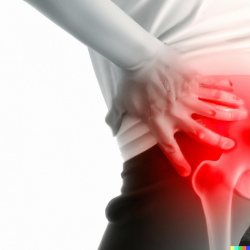Hip pain can significantly impact our daily lives, limiting our mobility and causing discomfort during activities as simple as walking or climbing stairs. One common cause of hip pain is hip bursitis, an inflammation of the bursae located around the hip joint. In this article, we will delve into a specific type of hip bursitis called greater trochanteric bursitis, exploring its causes, symptoms, diagnosis, and available treatment options.
What is Greater Trochanteric Bursitis?
Greater trochanteric bursitis, also known as hip bursitis or trochanteric bursitis, is the inflammation of the bursa located over the greater trochanter of the femur, which is the bony prominence on the outside of the hip. The bursa acts as a cushion between the greater trochanter and the surrounding soft tissues, such as muscles and tendons, reducing friction during movement.
Causes and Risk Factors:
Greater trochanteric bursitis can occur due to various factors, including:
Overuse or Repetitive Stress: Activities that involve repetitive movements of the hip joint, such as running or cycling, can lead to irritation and inflammation of the bursa.
Trauma or Injury: A direct blow to the hip, a fall, or a sudden impact can cause damage to the bursa, leading to inflammation.
Poor Biomechanics: Abnormalities in hip alignment or gait mechanics can put excessive stress on the bursa, leading to irritation and inflammation.
Muscle Imbalances: Weakness or tightness in the hip muscles, particularly the gluteus medius and minimus, can contribute to bursitis development.
Age and Gender: Greater trochanteric bursitis is more prevalent in women, especially middle-aged and older individuals.
Symptoms:
The most common symptom of greater trochanteric bursitis is pain on the outside of the hip, often radiating down the outer thigh. Additional symptoms may include:
Tenderness and swelling over the greater trochanter area.
Pain worsened by lying on the affected side or when performing activities involving hip movement.
Stiffness and limited range of motion in the hip joint.
Discomfort when walking or climbing stairs.
Diagnosis:
Diagnosing greater trochanteric bursitis typically involves a thorough examination by a healthcare professional. The doctor will review your medical history, perform a physical examination, and may order imaging tests such as X-rays, Ultrasounds or MRI scans to rule out other possible causes of hip pain.
Treatment:
Treatment for greater trochanteric bursitis aims to relieve pain, reduce inflammation, and improve hip function. Common treatment options include:
Rest and Activity Modification: Avoiding activities that aggravate the condition and engaging in low-impact exercises can help reduce stress on the hip joint.
Non-Steroidal Anti-Inflammatory Drugs (NSAIDs): Over-the-counter medications like ibuprofen or naproxen can help alleviate pain and reduce inflammation.
Osteopathy: An Osteopath can provide exercises and stretches to improve hip strength, flexibility, and posture.
Corticosteroid Injections: In severe cases, a corticosteroid injection may be administered directly into the bursa to reduce inflammation and relieve pain.
Assistive Devices: The use of crutches or a cane can help offload weight from the affected hip during the healing process.
if you have any further questions feel free to reach out to us at VicSportsRehab.

